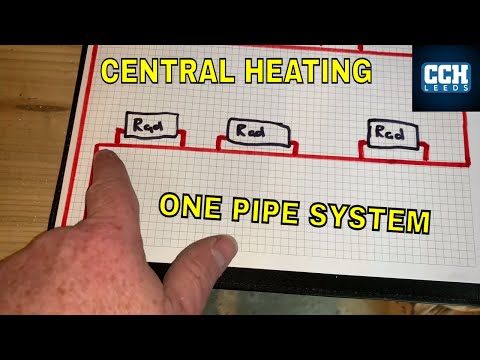ONE PIPE CENTRAL HEATING SYSTEM. How to install and how to adapt a central heating system. How to install a new radiator on a one pipe system. Today I wanted to pipe a central heating system up. I’m going to pipe this as a one pipe system. Nowadays we wouldn’t instal one pipe systems, but this is to show you what a one pipe system would look like. Also, if ever you need to go to a system, and you need to adapt it, and it’s a one pipe system, so that you understand what a one pipe system is, and you’re able to adapt to that. So yeah, I’d like to thank Trade Help for supporting this video. They have paid for the radiators, they’ve paid for the pipe and all the fittings, so that I could do this video for you. So yeah, let’s go and have a look now.
I’m going to do this as if it is a one pipe heating system with six radiators, and what we’ve got, I’ve got my radiator brackets on the wall here, and what I’m doing is this is upstairs, across here, all across there, and then obviously the brackets below, they’re for downstairs. I’m going to put some radiators on here now. When we used to instal one pipe systems, they used to have just an elbow on, if you see a heating system, and it’s got an elbow on, just like that, and it hasn’t got a valve, there’s a good chance it’s a one pipe system. As the years went on, sometimes people changed these, and they put TRVs on. That makes it a little bit harder to see if it’s a one pipe system or not, but I’ll show you some other ways that you can tell.
I’m now going to pipe this up as a one pipe system for downstairs. With a one pipe system I’ve got, well I’m going to use press fitting for this. I normally use press fit on all my jobs now, but what you find is you’ll have a T under there, and you’ll have a T under there, and the pipe will join together, which I’ll show you shortly. But on some one pipe systems, they actually went in series, so the pipe, it went into the radiator and then back out the other side, and then to the next radiator, and to the next radiator. Now, the issue with that is, if you turned one of the radiators off, it will turn all the system off. So then they had the pipes underneath so that the system would still work if you turned one of the radiators off. So, I’ll pipe this up now.
For anybody who is interested in press fitting, this is what I use now. I’ve just got my T there, so as much as possible I’ll just press these off, just like that. This T that I’ve got on this, this is actually a gas T. If you have a look inside, it’s got a yellow O ring, but I’m not going to use this system, I’m just doing it for this video, so it doesn’t matter. But yeah, going to fit some of this now.
When we do press fitting, we always make sure that the fitting is fully in. The good thing with using press fitting is that we’re not getting any muck in pipe, there’s no solder. No solder, no flux, and this has been used in commercial now for, I think it’s around 50 years. Most hospitals and places like that use press fit.
Some of the people that comment on these videos, they mistake these fittings for push fit, but these are press fit, so they’re crimped together. See there, you can see it’s got the mark on it, which is an M symbol, and that’s where it’s been crimped together.
I’ve piped what I would say is downstairs so far. I’m also going to show you how to adapt the system, if you come to a system where it’s a one pipe system and you need to add a new radiator, I’m going to show you how to do that as well. Also, different types of systems that you might be on, so I’ll try and talk through that as well. So it may be that it’s on an old style gravity boiler, it may be that it’s on a combi boiler, etc. So, we’ll have a little look at that as well.
So, as you can see here, if we imagine this is the flow around the system, so it’s just one circuit round the system. So, we’ve got a T there, it goes into this radiator, it also goes across the bottom of the radiator. So, if you imagine normally this would be under the floorboards. There’s different types of one pipe, sometimes it’ll come in the valve, one of the valves will come in the top. Most of the ones I’ve seen in domestic normally just come in bottom part, and they just come like this. So, again, we’ve got a pipe underneath there and a pipe underneath, and they’re just T-ed together. Come in a bit closer and I’ll just show you that bit.
So we can see there it just goes into radiator, comes back out of radiator, but also just comes comes along the bottom, and again with the rest of it. So, that’s why they say it’s one pipe, because it’s just one pipe throughout the system. Now, there is quite a few issues with this type of system. One is you wouldn’t be able to flush this system. So if it’s got muck in it, you wouldn’t be able to flush it, but we’ll go through some of them things shortly, but that’s how that looks so far.







